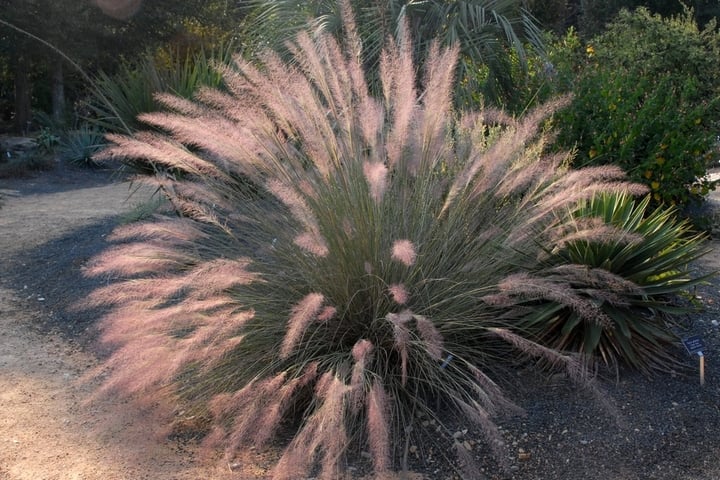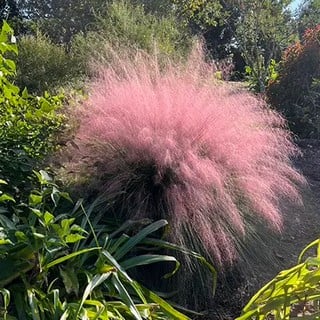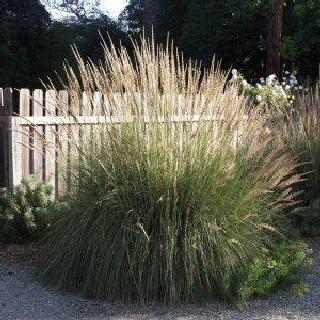Pink flamingo muhly is a hybrid cross of a Texas native that thrives in the southwest. When in bloom, its pink plumes are so fluffy they’ve been described as looking like clouds or even cotton candy. Here’s how to grow this tough but gorgeous ornamental grass.

Pink flamingo muhly (Muhlenbergia x ‘Pink Flamingo’) is a hybrid cross between pink muhly (Muhlenbergia capillaries) and big muhly (Muhlenbergia lindheimeri), two ornamental grasses native to the US.
This naturally occurring hybrid combines the attributes of both — pink muhly’s gorgeous flower stalks and big muhly’s strong upright form.
Plants have fine, blue-green leaves spring through winter. In the fall, they put on a show with clouds of wispy pink plumes that almost glow when backlit by the sun.
Pink flamingo muhly is a low-maintenance, resilient desert landscape plant that’s a boon to birds. They eat its seeds and use it to build nests and for shelter.
Why I Like This Plant
- Dazzling pink plumes
- Upright form, good for narrow spaces
- Low maintenance
- No thorns, non-toxic, non-invasive
- Deer resistant
Things to Watch Out For
Don’t expect pink flamingo muhly to look like the pictures all year. They bloom in the fall, and the pink flowers last about a month before turning tan. Plants go dormant in the winter and should be cut to the ground in late winter or early spring.
So be aware that while they are attractive even when not in bloom, they are not show-stoppers for most of the year.
Since some ornamental grasses are invasive, it’s wise to be concerned.
Pink flamingo muhly does not reseed in the landscape and is not invasive.
Optimal Growing Conditions
If you’re thinking of adding pink flamingo muhly to your garden, you need to find a suitable place that will keep your plant healthy and looking good… while minimizing maintenance for you.
Here are the key factors to keep in mind.
Temperature
Pink flamingo muhly should be grown in USDA Hardiness Zones 6 – 10. It is a tough, heat-loving plant that can also withstand extreme cold down to -10°F.
Sun Exposure
Pink flamingo muhly looks its best when planted in full sun, but also grows well in part to nearly full shade. It tolerates the reflected heat from buildings or walls.
Size and Growth Rate
Pink flamingo muhly is considered a fast grower that reaches a size of 3 to 5 feet tall by 2 to 3 feet wide. Flower spikes add an extra foot or two in height.
Soil
Pink flamingo muhly is not particular about soil and grows in sandy, rocky, or clay soil, provided it’s well-draining. It prefers neutral to slightly alkaline soil.
Other Location Considerations
Pink flamingo is a good choice if you’re looking for an ornamental grass to fit in a narrow space, since it grows upright and is taller than wide.
Because it has no thorns and produces minimal litter, it’s a plant you can feel comfortable placing near a pool or sidewalk, or anywhere it might come in contact with pets and people. (The only time it’s messy is when it’s time to prune.)

Its plumes are inviting, so you can expect that anyone walking by will be tempted to run their hands over the soft, airy inflorescences. Fortunately, they are not spiky, irritating, or toxic.
This grass is most effective when planted in drifts, but also makes an arresting specimen plant if you only have room for one.
Pink Flamingo Muhly:
The Essentials
| Common Name | Pink flamingo muhly |
| Scientific Name | Muhlenbergia x ‘Pink Flamingo’ |
| Origin | Eastern US, Texas (hybrid) |
| Plant Type | Bunch grass |
| USDA Zones | Zones 6 – 10 |
| Cold Hardy | To -10℉ |
| Flower Color | Pink |
| Flower Season | Fall |
| Mature Size | 3-5’ high x 2-3’ wide |
| Growth Rate | Fast |
| Sun Tolerance | Full, part, reflected sun |
| Water Needs | Low to moderate |
| Pests & Diseases | None |
| Garden Friendly | No thorns, non-toxic, not invasive |
| Wildlife | Deer resistant |
How to Plant
The rule of thumb when planting any ornamental grass is to dig a hole three times as wide as the root ball but no deeper. Amending the soil is not recommended. Counterintuitively, backfilling with the same native soil you just dug up helps your plant develop a stronger root system.
When to Plant
The best time to plant pink flamingo muhly is in the fall. This gives your grass three seasons to grow roots and get established before the following summer.
The second best time is in spring, the earlier the better. This still gives your plant time to get established before the intense heat of June arrives.
How to Care for Pink Flamingo Muhly
Whether you’ve recently planted a pink flamingo muhly or have an existing plant in your yard, here’s how to take care of it to keep it healthy and looking its best.
How to Water New Ornamental Grasses
Pink flamingo muhly needs very little water once established, but it does need regular watering after being planted.
Here is the recommended watering schedule for new ornamental grasses.
| Weeks 1 & 2 | Every 3 – 4 days |
| Weeks 3 & 4 | Every 6 – 7 days |
| Weeks 5 & 6 | Every 7 – 10 days |
| Weeks 7 & 8 | Every 10 – 14 days |
How to Water Established Plants
Once your pink flamingo muhly is established, water it deeply every week or two during the summer. While it can survive on less, it will look its best in the fall with regular watering during the summer.
Since plants go dormant in the winter, they only need water once a month, which is typically provided by winter rains.
Should You Fertilize?
Pink flamingo muhly can benefit from an annual application of fertilizer in the spring.
How to Prune
Pink flamingo muhly should be pruned hard once in late winter or early spring. Cut it down to 3 or 4 inches above the ground.
You can cut it straight across, but slightly irregular cuts look more natural and mimic the grazing that would occur when growing in grasslands, its native habitat. This lets light penetrate the crown and makes way for new spring growth.
Pro Tip!
Tightly tie the dried leaves and flower stalks
with string or duct tape before cutting.
This makes clean-up much easier.
Plant Lover Facts
‘Pink Flamingo’ is a hybrid cross between pink muhly (Muhlenbergia capillaries), a native of the eastern and southeastern US…

… and big muhly (Muhlenbergia lindheimeri), a native of Texas and northeastern Mexico.

This naturally occurring hybrid was discovered growing at the John Fairey Garden (formerly Peckerwood Garden) which lies between Austin and Houston, Texas.
The genus, Muhlenbergia, was named after the German botanist Gotthilf Muhlenberg, who is credited with classifying and naming at least 150 plant species.
Muhlenbergia is a genus of 175 grasses, mostly native to the desert southwest. Only a handful are grown as landscape plants.
Did you enjoy this article?
Sign up for our weekly newsletter
where you’ll find more great info on creating &
maintaining a beautiful, carefree desert landscape.
Author Bio
Deane Alban is the creator of Southwest Gardener. She is a science writer with a bachelor’s degree in botany from the University of South Florida. Gardening is her lifelong passion. She’s been gardening in Tucson for over 15 years.

